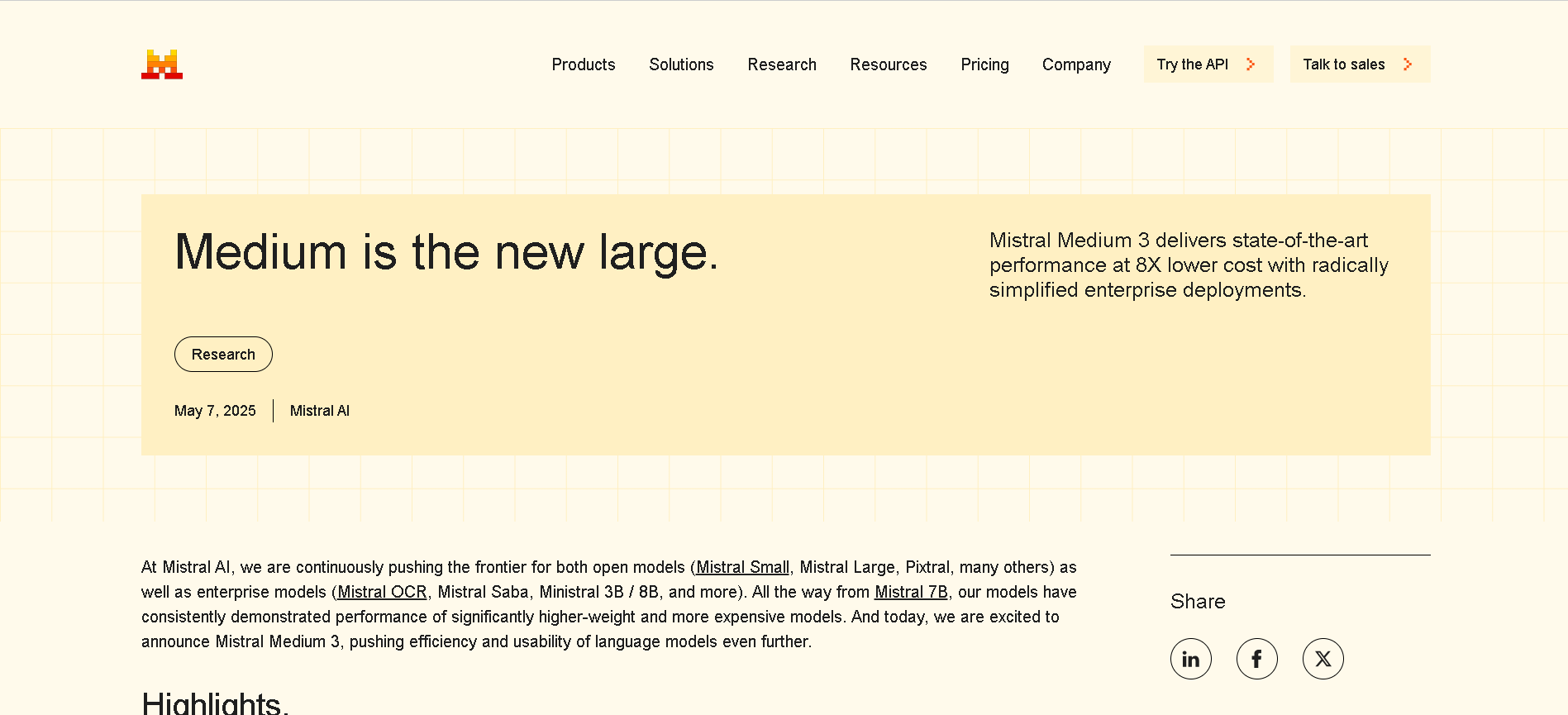
- Enterprise & Cloud Teams: Deploy hybrid, in-VPC, or on-premises setups using just four GPUs.
- Developers & Engineers: Build coding assistants, document parsers, or multimodal agents with function calling and long-text support.
- Data Scientists & Analysts: Analyze technical documents, codebases, images, and business data with a single model.
- Researchers & Evaluators: Benchmark on coding, STEM, multimodal tasks thanks to high accuracy at low cost.
- Early Adopters in Regulated Fields: Finance, healthcare, energy sectors using secure, customizable AI pipelines.
How to Use Mistral Medium 3?
- Access the Model: Available via Mistral’s API (`mistral-medium-2505`), Amazon SageMaker, IBM watsonx, NVIDIA NIM, Azure Foundry, and Google Vertex.
- Send Prompts: Input text and images, context up to 128K tokens for extensive pipelines.
- Use in Enterprise: Self-host on four GPUs or customize with post-training to embed internal knowledge.
- Monitor Costs: Approx. $0.40 per million input tokens, $2 per million output tokens—8× cheaper than rivals.
- Deploy Agents & Function Calls: Integrates seamlessly with tool-calling APIs and structured outputs.
- Cost-Efficient Frontier Performance: Matches ~90% of Claude Sonnet 3.7 and outpaces Llama 4 Maverick—while being 8× cheaper and faster.
- Frontline Coding & STEM: Outstanding 0-shot results—HumanEval (92.1%), Math500 (91%), ArenaHard (97.1%).
- Vision + Text + Long Context: Supports multimodal tasks like DocVQA (95.3%) and long-form understanding to 128K tokens.
- Enterprise Deployability: Easily self-hostable on four GPUs; supports post-training and in-VPC deployment.
- Wide Platform Reach: Available across major cloud providers and enterprise AI stacks.
- High performance in coding, STEM, and multimodal tasks
- Cost-efficient token pricing ideal for scale
- Supports long-context pipelines and function calls
- Flexible deployment options including self-hosted & customizable
- Broad enterprise and cloud integration
- Not open-source; proprietary weights
- Four‑GPU requirement may limit smaller teams
- Enterprise pricing and support needed for customization
Chat
0/$14.99/$24.99 per month
Free - $0
Pro - $14.99 per month
Enterprise - $24.99 per month
API
$0.40/$2 per 1M tokens
Proud of the love you're getting? Show off your AI Toolbook reviews—then invite more fans to share the love and build your credibility.
Add an AI Toolbook badge to your site—an easy way to drive followers, showcase updates, and collect reviews. It's like a mini 24/7 billboard for your AI.
Reviews
Rating Distribution
Average score
Popular Mention
FAQs
Similar AI Tools
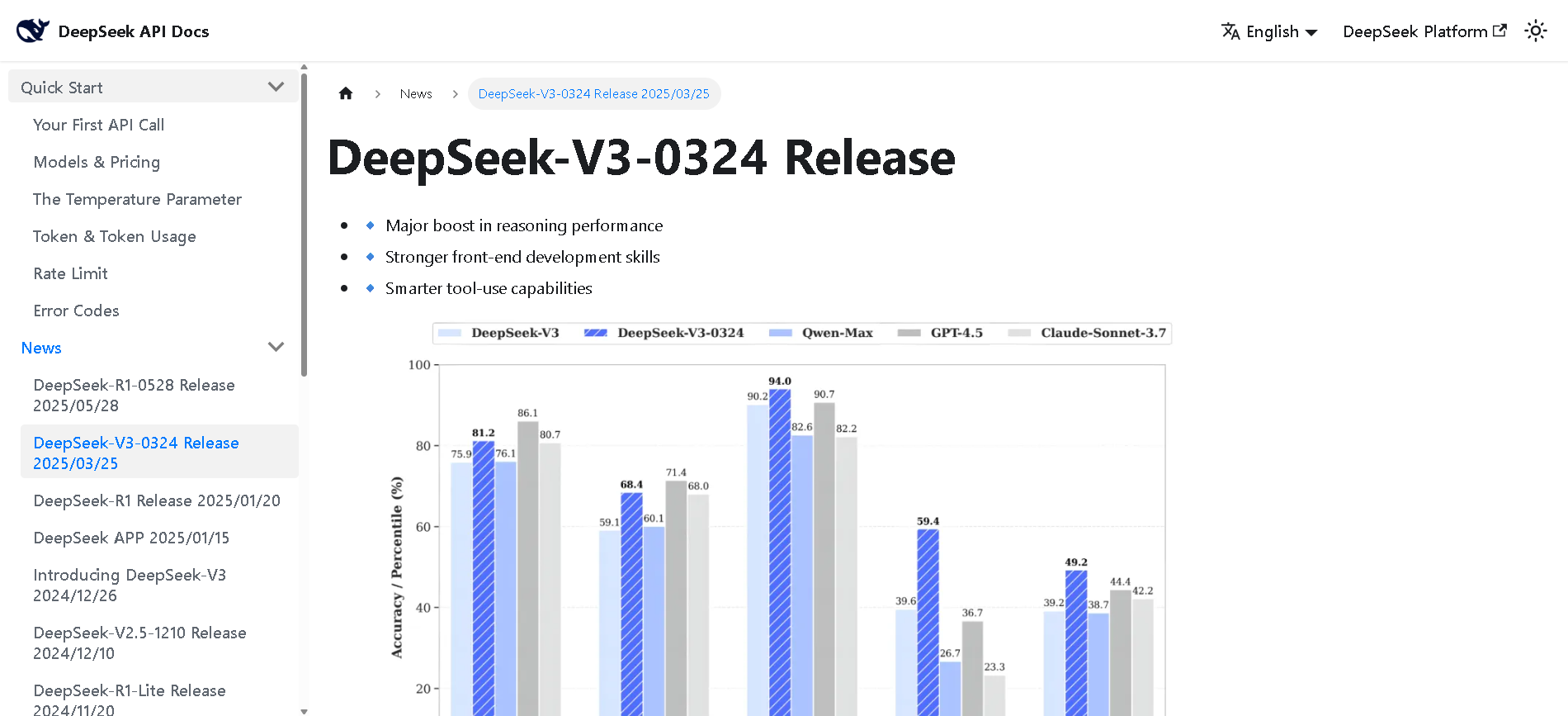

DeepSeek-V3-0324
DeepSeek V3 (0324) is the latest open-source Mixture-of-Experts (MoE) language model from DeepSeek, featuring 671B parameters (37B active per token). Released in March 2025 under the MIT license, it builds on DeepSeek V3 with major enhancements in reasoning, coding, front-end generation, and Chinese proficiency. It maintains cost-efficiency and function-calling support.


DeepSeek-V3-0324
DeepSeek V3 (0324) is the latest open-source Mixture-of-Experts (MoE) language model from DeepSeek, featuring 671B parameters (37B active per token). Released in March 2025 under the MIT license, it builds on DeepSeek V3 with major enhancements in reasoning, coding, front-end generation, and Chinese proficiency. It maintains cost-efficiency and function-calling support.


DeepSeek-V3-0324
DeepSeek V3 (0324) is the latest open-source Mixture-of-Experts (MoE) language model from DeepSeek, featuring 671B parameters (37B active per token). Released in March 2025 under the MIT license, it builds on DeepSeek V3 with major enhancements in reasoning, coding, front-end generation, and Chinese proficiency. It maintains cost-efficiency and function-calling support.


Claude 3 Opus
Claude 3 Opus is Anthropic’s flagship Claude 3 model, released March 4, 2024. It offers top-tier performance for deep reasoning, complex code, advanced math, and multimodal understanding—including charts and documents—supported by a 200K‑token context window (extendable to 1 million in select enterprise cases). It consistently outperforms GPT‑4 and Gemini Ultra on benchmark tests like MMLU, HumanEval, HellaSwag, and more.


Claude 3 Opus
Claude 3 Opus is Anthropic’s flagship Claude 3 model, released March 4, 2024. It offers top-tier performance for deep reasoning, complex code, advanced math, and multimodal understanding—including charts and documents—supported by a 200K‑token context window (extendable to 1 million in select enterprise cases). It consistently outperforms GPT‑4 and Gemini Ultra on benchmark tests like MMLU, HumanEval, HellaSwag, and more.


Claude 3 Opus
Claude 3 Opus is Anthropic’s flagship Claude 3 model, released March 4, 2024. It offers top-tier performance for deep reasoning, complex code, advanced math, and multimodal understanding—including charts and documents—supported by a 200K‑token context window (extendable to 1 million in select enterprise cases). It consistently outperforms GPT‑4 and Gemini Ultra on benchmark tests like MMLU, HumanEval, HellaSwag, and more.
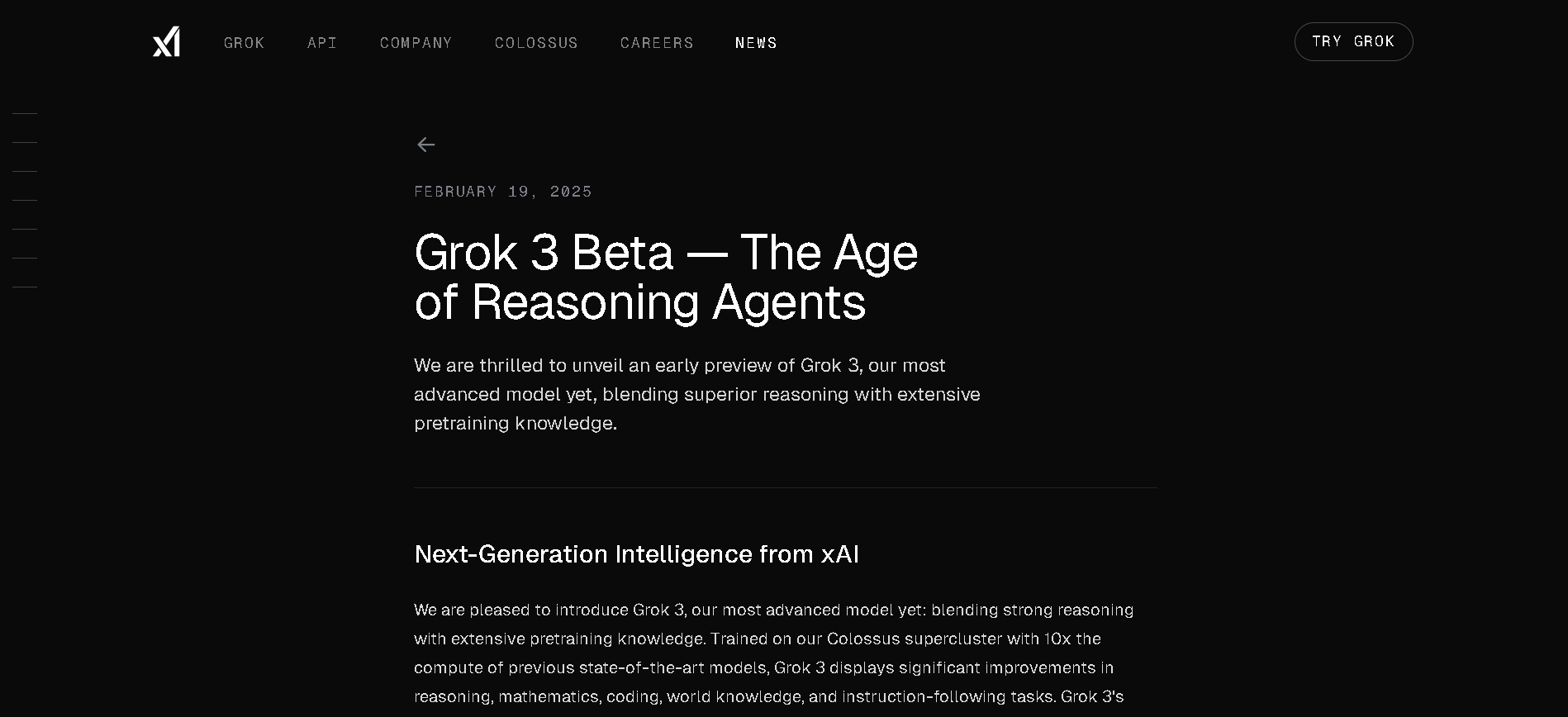
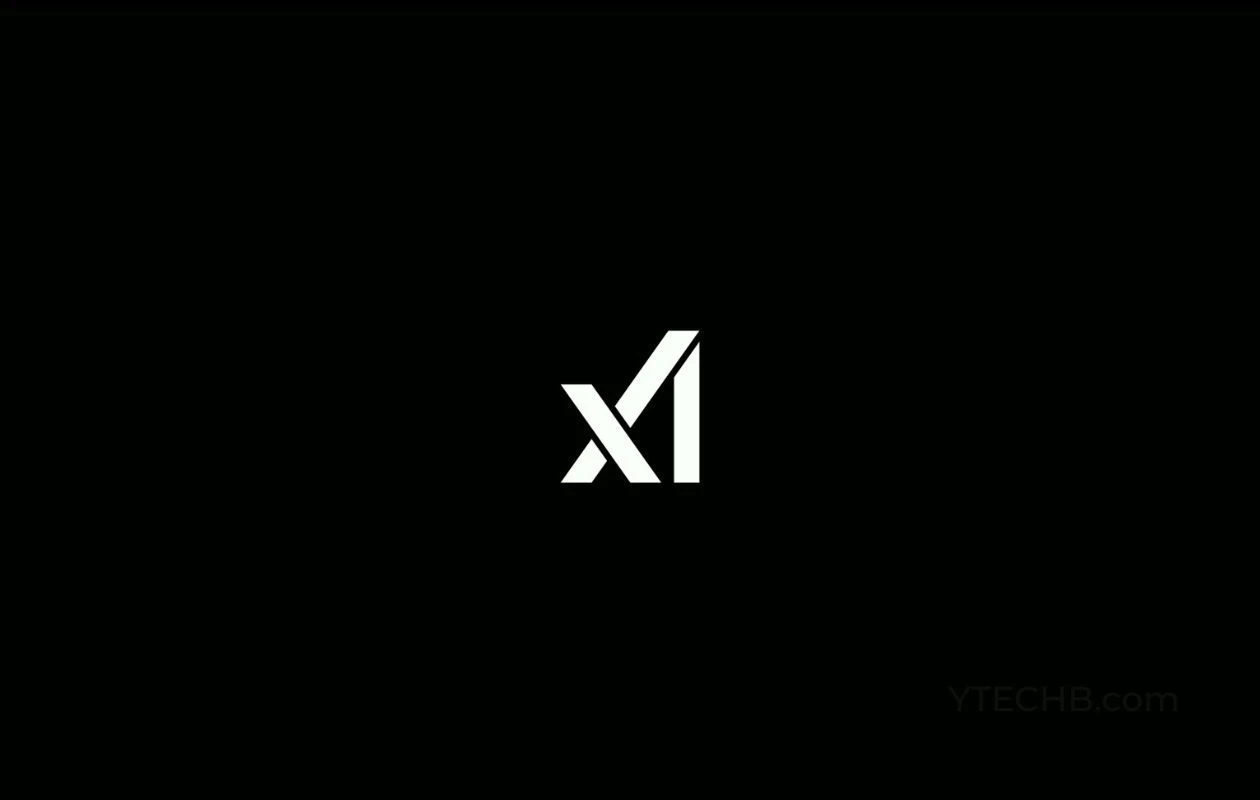
Grok 3 Latest
Grok 3 is xAI’s newest flagship AI chatbot, released on February 17, 2025, running on the massive Colossus supercluster (~200,000 GPUs). It offers elite-level reasoning, chain-of-thought transparency (“Think” mode), advanced “Big Brain” deeper reasoning, multimodal support (text, images), and integrated real-time DeepSearch—positioning it as a top-tier competitor to GPT‑4o, Gemini, Claude, and DeepSeek V3 on benchmarks.


Grok 3 Latest
Grok 3 is xAI’s newest flagship AI chatbot, released on February 17, 2025, running on the massive Colossus supercluster (~200,000 GPUs). It offers elite-level reasoning, chain-of-thought transparency (“Think” mode), advanced “Big Brain” deeper reasoning, multimodal support (text, images), and integrated real-time DeepSearch—positioning it as a top-tier competitor to GPT‑4o, Gemini, Claude, and DeepSeek V3 on benchmarks.


Grok 3 Latest
Grok 3 is xAI’s newest flagship AI chatbot, released on February 17, 2025, running on the massive Colossus supercluster (~200,000 GPUs). It offers elite-level reasoning, chain-of-thought transparency (“Think” mode), advanced “Big Brain” deeper reasoning, multimodal support (text, images), and integrated real-time DeepSearch—positioning it as a top-tier competitor to GPT‑4o, Gemini, Claude, and DeepSeek V3 on benchmarks.
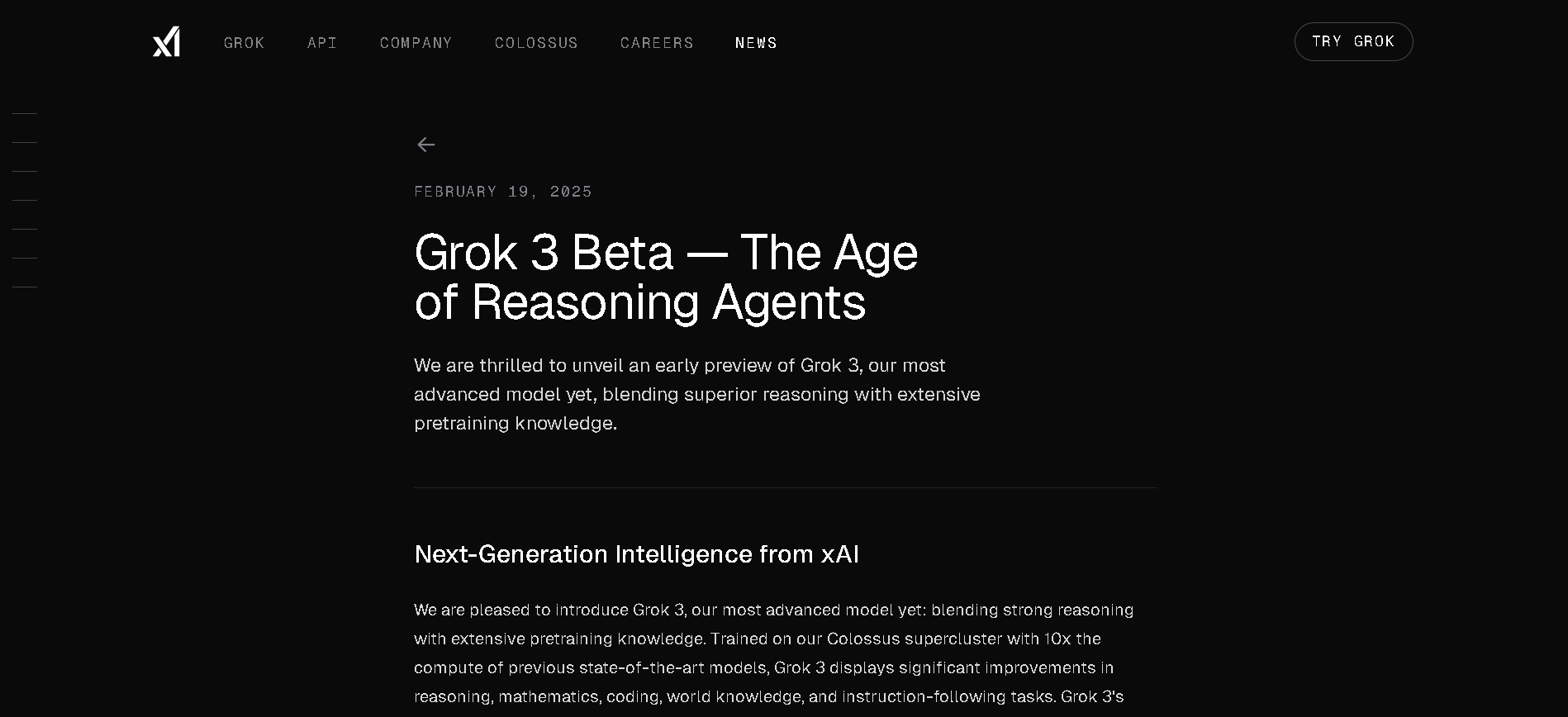
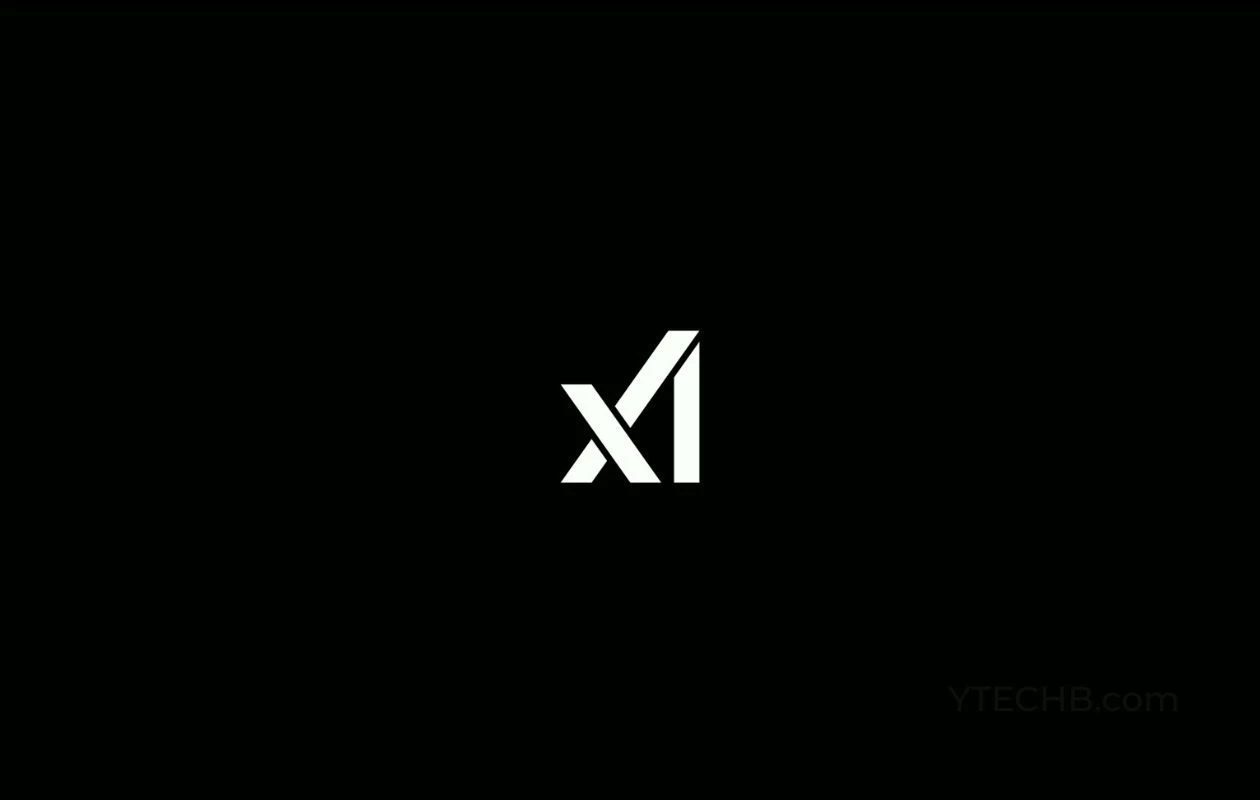
grok-3-fast-latest
Grok 3 Fast is xAI’s speed-optimized variant of their flagship Grok 3 model, offering identical output quality with lower latency. It leverages the same underlying architecture—including multimodal input, chain-of-thought reasoning, and large context—but serves through optimized infrastructure for real-time responsiveness. It supports up to 131,072 tokens of context.


grok-3-fast-latest
Grok 3 Fast is xAI’s speed-optimized variant of their flagship Grok 3 model, offering identical output quality with lower latency. It leverages the same underlying architecture—including multimodal input, chain-of-thought reasoning, and large context—but serves through optimized infrastructure for real-time responsiveness. It supports up to 131,072 tokens of context.


grok-3-fast-latest
Grok 3 Fast is xAI’s speed-optimized variant of their flagship Grok 3 model, offering identical output quality with lower latency. It leverages the same underlying architecture—including multimodal input, chain-of-thought reasoning, and large context—but serves through optimized infrastructure for real-time responsiveness. It supports up to 131,072 tokens of context.
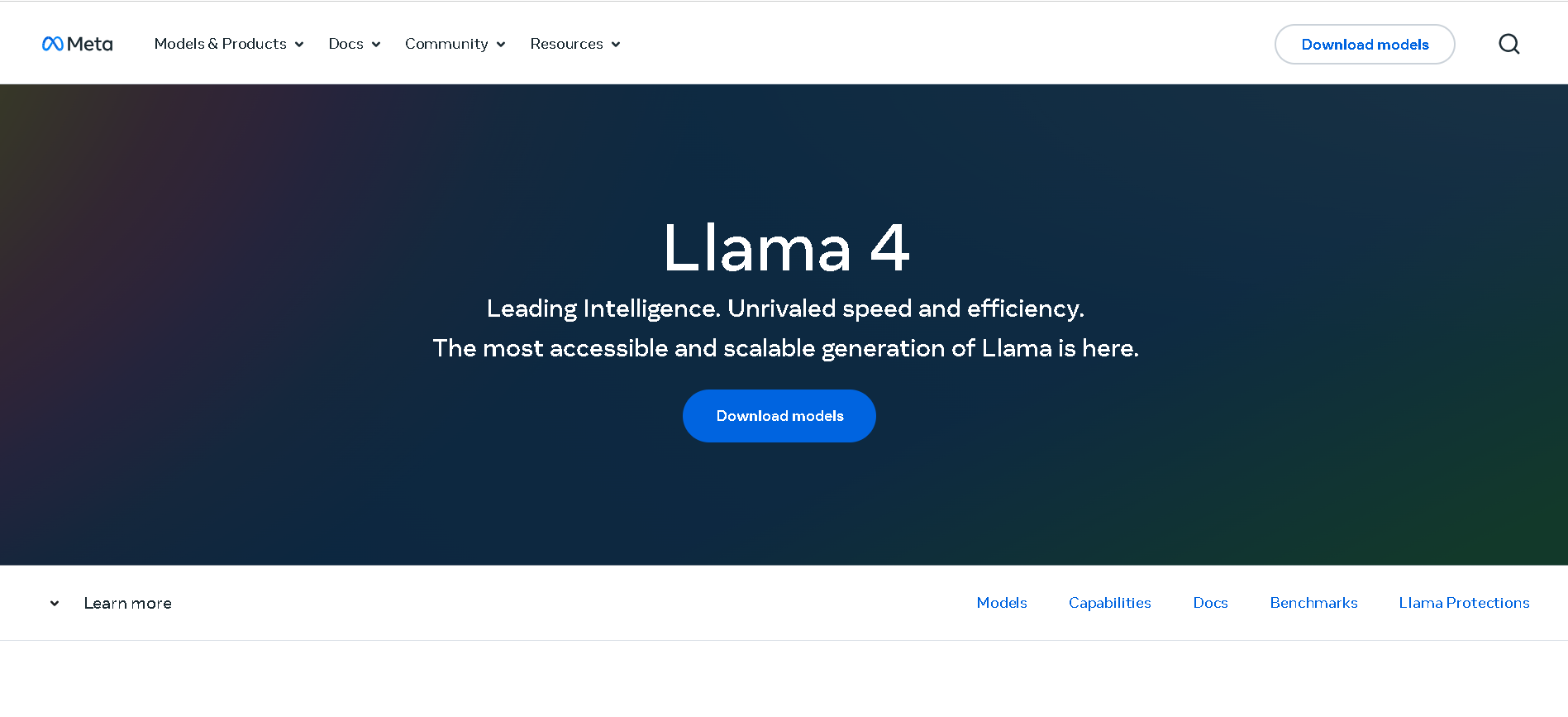

Meta Llama 4 Scout
Llama 4 Scout is Meta’s compact and high-performance entry in the Llama 4 family, released April 5, 2025. Built on a mixture-of-experts (MoE) architecture with 17B active parameters (109B total) and a staggering 10‑million-token context window, it delivers top-tier speed and long-context reasoning while fitting on a single Nvidia H100 GPU. It outperforms models like Google's Gemma 3, Gemini 2.0 Flash‑Lite, and Mistral 3.1 across benchmarks.


Meta Llama 4 Scout
Llama 4 Scout is Meta’s compact and high-performance entry in the Llama 4 family, released April 5, 2025. Built on a mixture-of-experts (MoE) architecture with 17B active parameters (109B total) and a staggering 10‑million-token context window, it delivers top-tier speed and long-context reasoning while fitting on a single Nvidia H100 GPU. It outperforms models like Google's Gemma 3, Gemini 2.0 Flash‑Lite, and Mistral 3.1 across benchmarks.


Meta Llama 4 Scout
Llama 4 Scout is Meta’s compact and high-performance entry in the Llama 4 family, released April 5, 2025. Built on a mixture-of-experts (MoE) architecture with 17B active parameters (109B total) and a staggering 10‑million-token context window, it delivers top-tier speed and long-context reasoning while fitting on a single Nvidia H100 GPU. It outperforms models like Google's Gemma 3, Gemini 2.0 Flash‑Lite, and Mistral 3.1 across benchmarks.
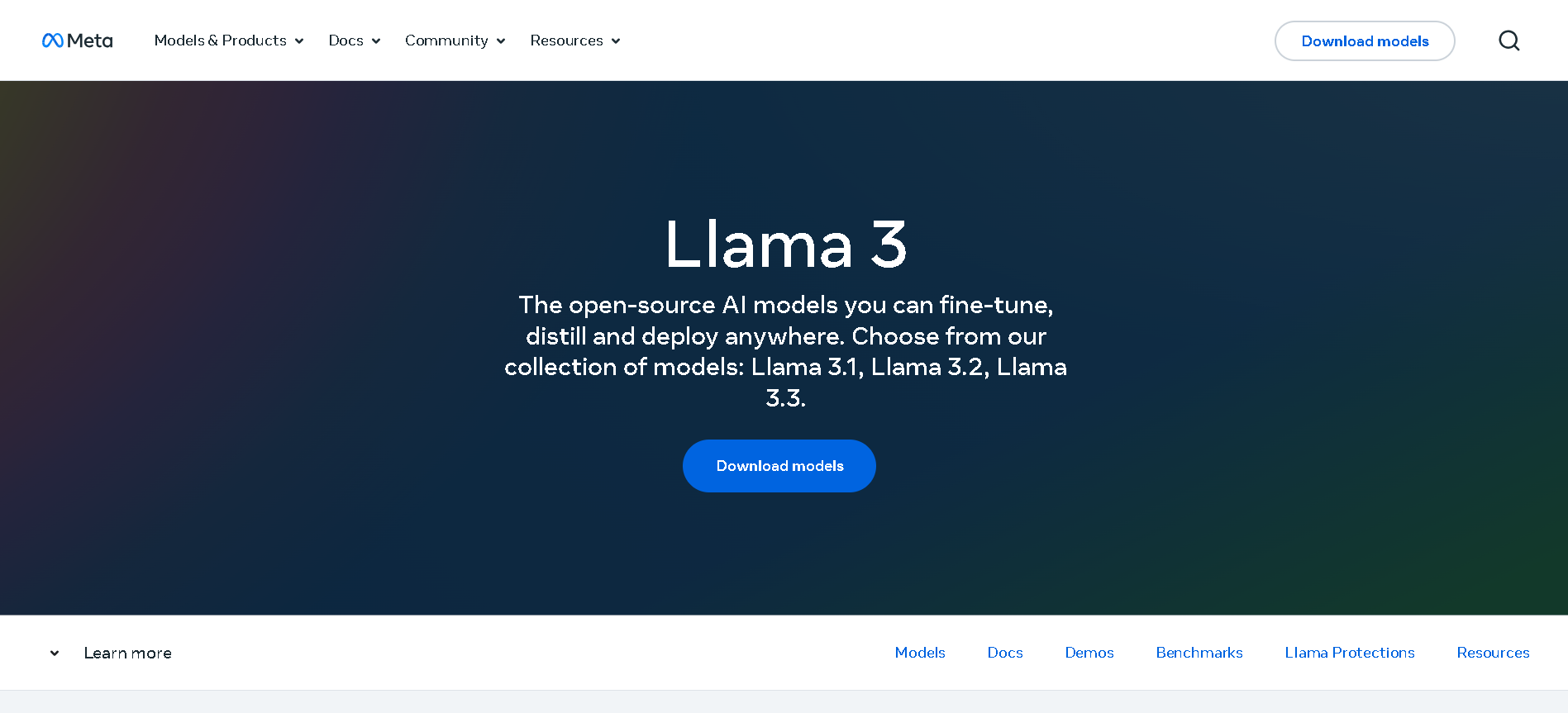
Llama 3.2 Vision is Meta’s first open-source multimodal Llama model series, released on September 25, 2024. Available in 11 B and 90 B parameter sizes, it merges advanced image understanding with a massive 128 K‑token text context. Optimized for vision reasoning, captioning, document QA, and visual math tasks, it outperforms many closed-source multimodal models.


Meta Llama 3.2 Vis..
Llama 3.2 Vision is Meta’s first open-source multimodal Llama model series, released on September 25, 2024. Available in 11 B and 90 B parameter sizes, it merges advanced image understanding with a massive 128 K‑token text context. Optimized for vision reasoning, captioning, document QA, and visual math tasks, it outperforms many closed-source multimodal models.


Meta Llama 3.2 Vis..
Llama 3.2 Vision is Meta’s first open-source multimodal Llama model series, released on September 25, 2024. Available in 11 B and 90 B parameter sizes, it merges advanced image understanding with a massive 128 K‑token text context. Optimized for vision reasoning, captioning, document QA, and visual math tasks, it outperforms many closed-source multimodal models.
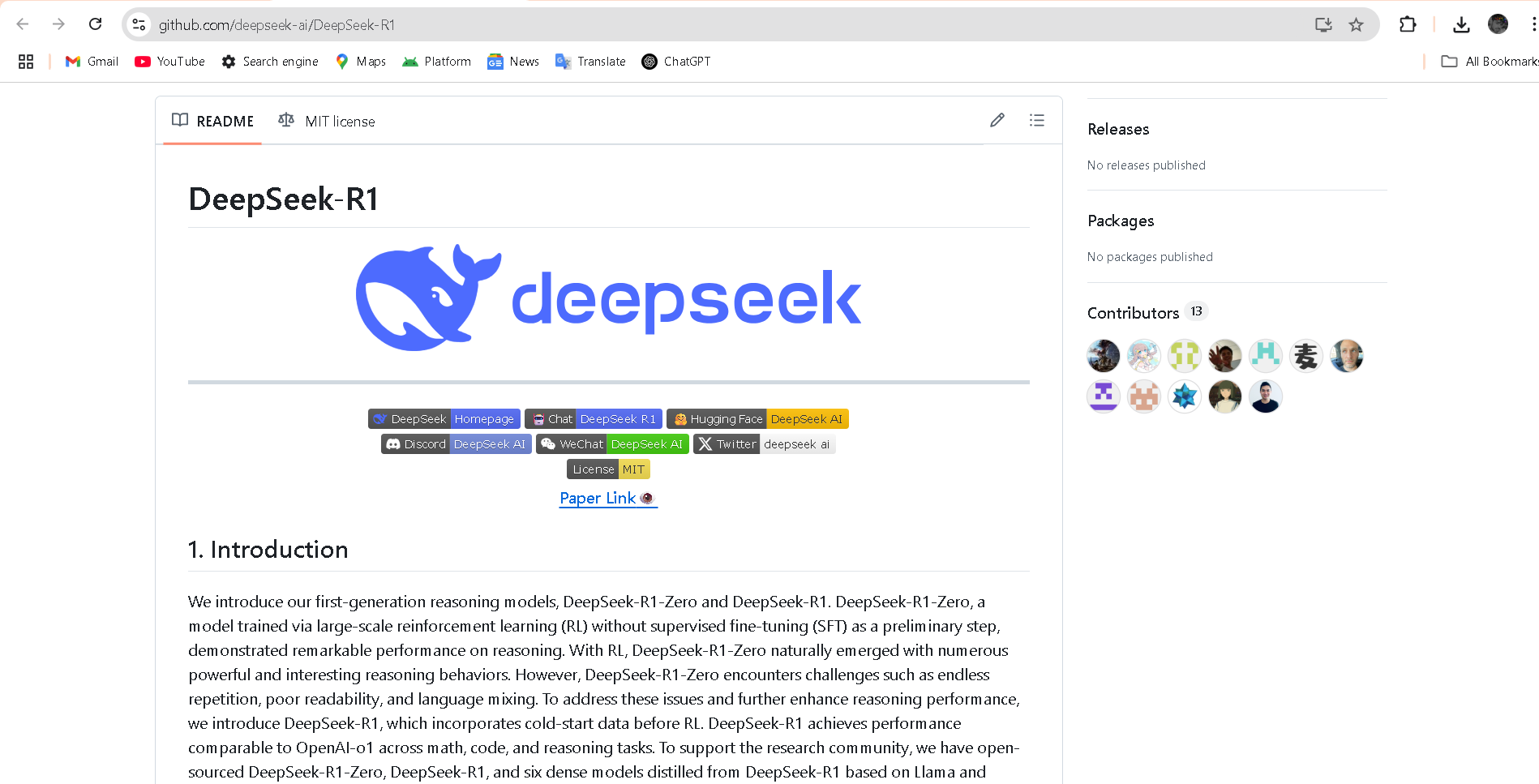

DeepSeek-R1-0528-Q..
DeepSeek R1 0528 – Qwen3 ‑ 8B is an 8 B-parameter dense model distilled from DeepSeek‑R1‑0528 using Qwen3‑8B as its base. Released in May 2025, it transfers high-depth chain-of-thought reasoning into a compact architecture while achieving benchmark-leading results close to much larger models.


DeepSeek-R1-0528-Q..
DeepSeek R1 0528 – Qwen3 ‑ 8B is an 8 B-parameter dense model distilled from DeepSeek‑R1‑0528 using Qwen3‑8B as its base. Released in May 2025, it transfers high-depth chain-of-thought reasoning into a compact architecture while achieving benchmark-leading results close to much larger models.


DeepSeek-R1-0528-Q..
DeepSeek R1 0528 – Qwen3 ‑ 8B is an 8 B-parameter dense model distilled from DeepSeek‑R1‑0528 using Qwen3‑8B as its base. Released in May 2025, it transfers high-depth chain-of-thought reasoning into a compact architecture while achieving benchmark-leading results close to much larger models.
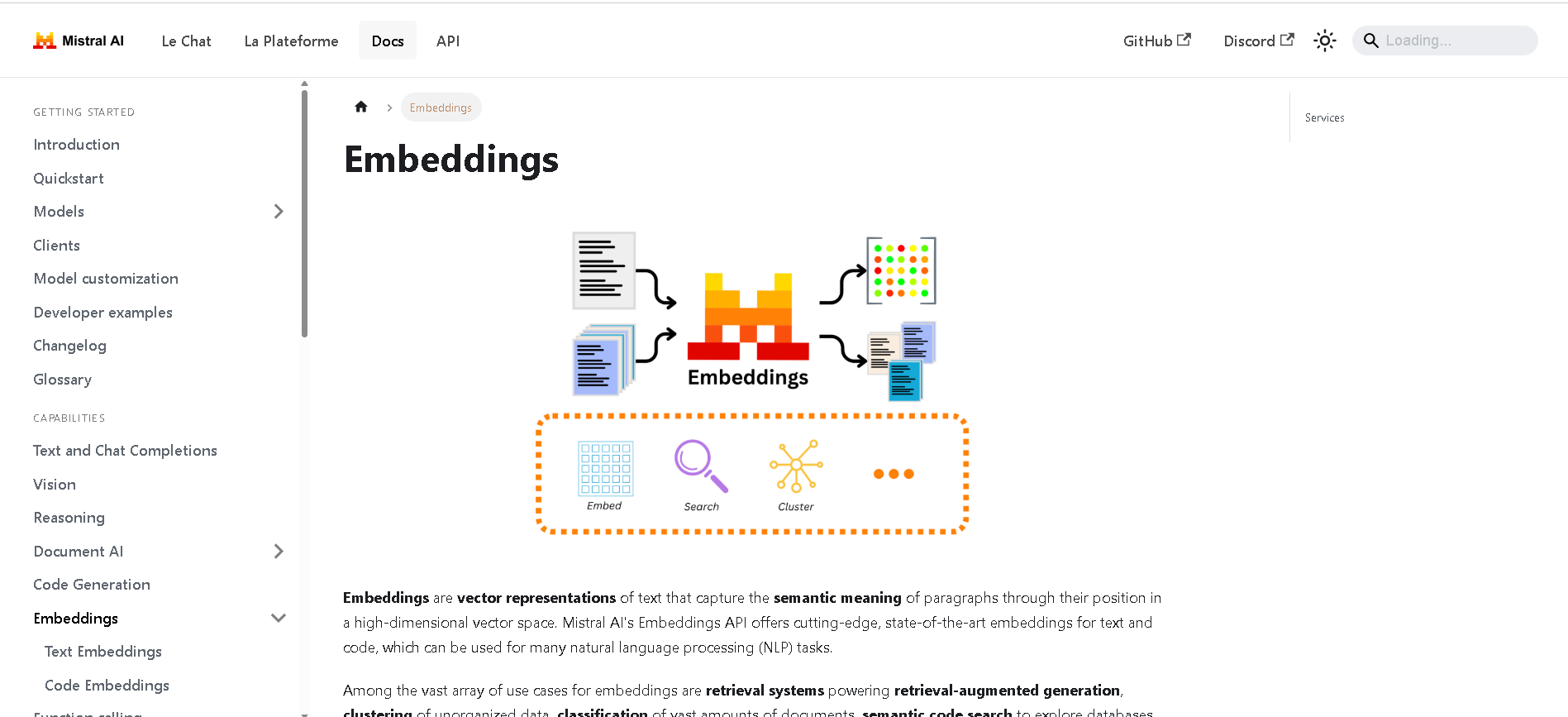
Mistral Embed
Mistral Embed is Mistral AI’s high-performance text embedding model designed for semantic retrieval, clustering, classification, and retrieval-augmented generation (RAG). With support for up to 8,192 tokens and producing 1,024-dimensional vectors, it delivers state-of-the-art semantic similarity and organization capabilities.

Mistral Embed
Mistral Embed is Mistral AI’s high-performance text embedding model designed for semantic retrieval, clustering, classification, and retrieval-augmented generation (RAG). With support for up to 8,192 tokens and producing 1,024-dimensional vectors, it delivers state-of-the-art semantic similarity and organization capabilities.

Mistral Embed
Mistral Embed is Mistral AI’s high-performance text embedding model designed for semantic retrieval, clustering, classification, and retrieval-augmented generation (RAG). With support for up to 8,192 tokens and producing 1,024-dimensional vectors, it delivers state-of-the-art semantic similarity and organization capabilities.

Mistral Moderation..
Mistral Moderation API is a content moderation service released in November 2024, powered by a fine-tuned version of Mistral’s Ministral 8B model. It classifies text across nine safety categories—sexual content, hate/discrimination, violence/threats, dangerous/criminal instructions, self‑harm, health, financial, legal, and personally identifiable information (PII). It offers two endpoints: one for raw text and one optimized for conversational content.

Mistral Moderation..
Mistral Moderation API is a content moderation service released in November 2024, powered by a fine-tuned version of Mistral’s Ministral 8B model. It classifies text across nine safety categories—sexual content, hate/discrimination, violence/threats, dangerous/criminal instructions, self‑harm, health, financial, legal, and personally identifiable information (PII). It offers two endpoints: one for raw text and one optimized for conversational content.

Mistral Moderation..
Mistral Moderation API is a content moderation service released in November 2024, powered by a fine-tuned version of Mistral’s Ministral 8B model. It classifies text across nine safety categories—sexual content, hate/discrimination, violence/threats, dangerous/criminal instructions, self‑harm, health, financial, legal, and personally identifiable information (PII). It offers two endpoints: one for raw text and one optimized for conversational content.
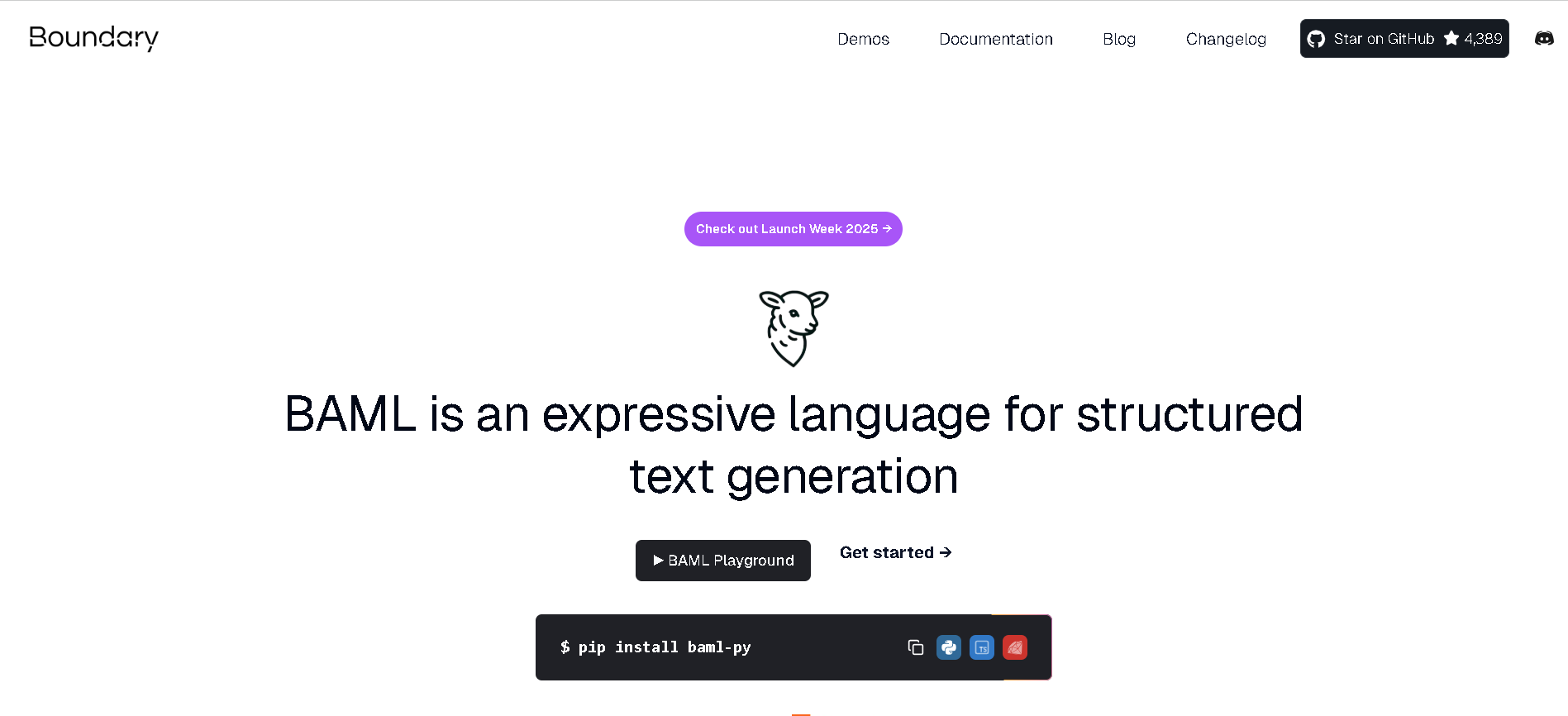
Boundary AI
BoundaryML.com introduces BAML, an expressive language specifically designed for structured text generation with Large Language Models (LLMs). Its primary purpose is to simplify and enhance the process of obtaining structured data (like JSON) from LLMs, moving beyond the challenges of traditional methods by providing robust parsing, error correction, and reliable function-calling capabilities.

Boundary AI
BoundaryML.com introduces BAML, an expressive language specifically designed for structured text generation with Large Language Models (LLMs). Its primary purpose is to simplify and enhance the process of obtaining structured data (like JSON) from LLMs, moving beyond the challenges of traditional methods by providing robust parsing, error correction, and reliable function-calling capabilities.

Boundary AI
BoundaryML.com introduces BAML, an expressive language specifically designed for structured text generation with Large Language Models (LLMs). Its primary purpose is to simplify and enhance the process of obtaining structured data (like JSON) from LLMs, moving beyond the challenges of traditional methods by providing robust parsing, error correction, and reliable function-calling capabilities.


WebDev Arena
LMArena is an open, crowdsourced platform for evaluating large language models (LLMs) based on human preferences. Rather than relying purely on automated benchmarks, it presents paired responses from different models to users, who vote for which is better. These votes build live leaderboards, revealing which models perform best in real-use scenarios. Key features include prompt-to-leaderboard comparison, transparent evaluation methods, style control for how responses are formatted, and auditability of feedback data. The platform is particularly valuable for researchers, developers, and AI labs that want to understand how their models compare when judged by real people, not just metrics.


WebDev Arena
LMArena is an open, crowdsourced platform for evaluating large language models (LLMs) based on human preferences. Rather than relying purely on automated benchmarks, it presents paired responses from different models to users, who vote for which is better. These votes build live leaderboards, revealing which models perform best in real-use scenarios. Key features include prompt-to-leaderboard comparison, transparent evaluation methods, style control for how responses are formatted, and auditability of feedback data. The platform is particularly valuable for researchers, developers, and AI labs that want to understand how their models compare when judged by real people, not just metrics.


WebDev Arena
LMArena is an open, crowdsourced platform for evaluating large language models (LLMs) based on human preferences. Rather than relying purely on automated benchmarks, it presents paired responses from different models to users, who vote for which is better. These votes build live leaderboards, revealing which models perform best in real-use scenarios. Key features include prompt-to-leaderboard comparison, transparent evaluation methods, style control for how responses are formatted, and auditability of feedback data. The platform is particularly valuable for researchers, developers, and AI labs that want to understand how their models compare when judged by real people, not just metrics.

Devstral-2 from Mi..
Devstral 2 is an advanced AI developer-focused model introduced by Mistral AI, designed to enhance coding, reasoning, and software development workflows. Built for high performance and efficiency, Devstral 2 supports complex code generation, debugging, and technical problem-solving, helping developers and teams accelerate product development with reliable AI assistance.

Devstral-2 from Mi..
Devstral 2 is an advanced AI developer-focused model introduced by Mistral AI, designed to enhance coding, reasoning, and software development workflows. Built for high performance and efficiency, Devstral 2 supports complex code generation, debugging, and technical problem-solving, helping developers and teams accelerate product development with reliable AI assistance.

Devstral-2 from Mi..
Devstral 2 is an advanced AI developer-focused model introduced by Mistral AI, designed to enhance coding, reasoning, and software development workflows. Built for high performance and efficiency, Devstral 2 supports complex code generation, debugging, and technical problem-solving, helping developers and teams accelerate product development with reliable AI assistance.
Editorial Note
This page was researched and written by the ATB Editorial Team. Our team researches each AI tool by reviewing its official website, testing features, exploring real use cases, and considering user feedback. Every page is fact-checked and regularly updated to ensure the information stays accurate, neutral, and useful for our readers.
If you have any suggestions or questions, email us at hello@aitoolbook.ai